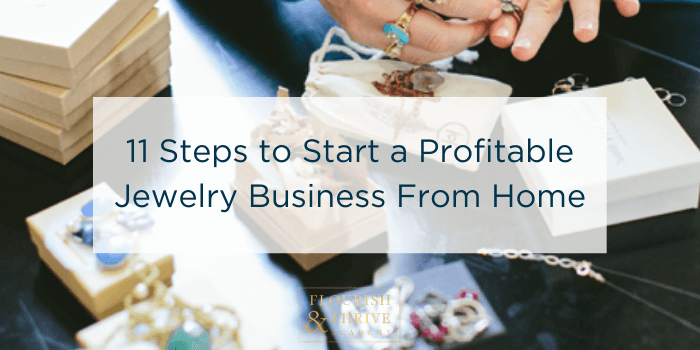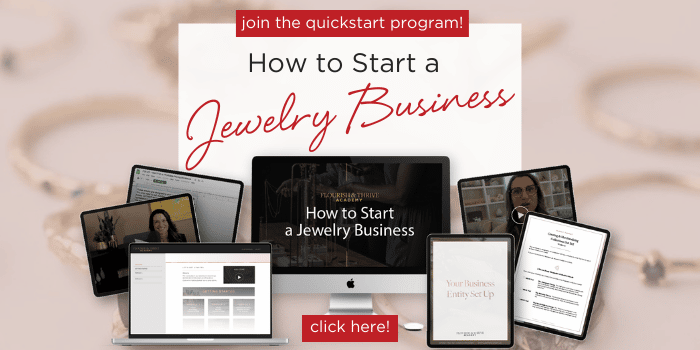Beginner’s Guide to Starting Your Own Jewelry Business

You’ve got a talent for jewelry design and making. Now you’re thinking about starting a jewelry business (or maybe you’ve already started)!
Now, jewelry making and selling your jewelry are two entirely different things. There’s a lot to consider when making the transition from a jewelry side hobby to a money making business.
Start your home-based online jewelry business
If you are an artist like me, you might not naturally think about how to launch a jewelry business the right way. When I started my first jewelry business in college, it wasn’t some master plan I carefully thought out. It just sort of…happened.
I’d been selling jewelry to my family and friends and my client base was expanding beyond my personal network. At that point, it made sense to try starting a legit jewelry business. While it sounded good on paper, my creativity got in the way, and I ended up making some big mistakes.
They say time is money, and I don’t want you to waste your time making the same mistakes I did. I put together this 11-step plan for starting a jewelry business from home and setting up your business the right way.
Have You Heard About Our Step-By-Step Programs That Have Helped Over 7,500 Jewelry Designers and Makers?
If You Don't Have Your First Customer…
If you're brand-new and need help starting your first jewelry business, check out our How to Start a Jewelry Business ‘Quick-Start' Program designed to help you get up and running so you can start making sales without all of the overwhelm.

If You Already Have Paying Customers…
If you already have customers, check out our signature program, Laying the Foundation, so you can move beyond ‘friends and family, refine your jewelry collections, and make consistent sales with less effort.

Step 1: Define your Niche
The jewelry industry in the United states is expected to reach $480.5 billion by 2025. Although extremely competitive and saturated, this market still offers plenty of opportunity for new designers and savvy entrepreneurs who can carve out a niche.
Narrow down your jewelry category
Successful jewelry businesses need to have a clear vision and understanding of their niche style and market. In order to define your niche, you should first determine which type of jewelry you want to sell. Understanding the market your jewelry caters to will help you identify your target audience and competition in order to discover trends and opportunities.
While there are many types of jewelry, most accessories fall under 3 main categories:
Costume Jewelry
Costume jewelry is your everyday, fashionable accessories made out of a range of materials such as metal, copper, wood and plastic. Since costume jewelry is meant to mix and match with style, it is affordable and usually costs under $100.
Fine jewelry
Fine jewelry describes precious stones like diamonds, gemstones, and rubies and metals like solid gold and sterling silver. This type of high quality jewelry is considered luxury and tends to have a higher price point than costume jewelry. A piece of fine jewelry can range anywhere from $100 to $3,000 or more.
A designer who sells fine jewelry will have a completely different market than one who designs costume jewelry.
Handmade jewelry
The demand for handmade jewelry has become extremely popular over the last decade thanks to sites like Etsy which have allowed independent, creative artists to sell their jewelry online. Handmade jewelry is usually made-to-order, not mass-produced.
From engraved deer bone bracelets to necklaces made from recycled skateboards, handmade jewelry is perfect for carving out a niche, however it can be a challenging business model to produce at scale. This type of jewelry ranges in price depending upon the materials and labor involved in the production.
Identify jewelry trends
Staying up to date with the latest jewelry and fashion blogs, following influencers, and industry specific publications helps you discover new and upcoming trends in your space.
Current events and culture shifts also lead to emerging trends, so keeping your eyes on parallel industries and economic factors can also help identify new consumer habits and needs.
Step 2: Understand Your Potential Customers (And Why They Want Your Jewelry)

Fun fact: the looks and styles that you like might be a little different from the people interested in buying from you. For years, I only designed what I personally liked instead of thinking about who I was actually designing for.
One of the biggest mistakes in jewelry design is assuming that everyone will like your pieces. When you follow the mentality of “designing for the masses”, chances are you’ll end up losing the features of your work that make you unique and special. Even worse, you’ll likely lose sight of designing for your dream customers. This can put you on a fast track to having to close down your business.
Before you really dive into planning and producing a jewelry line, take a hard look at who your dream clients might be. Take time to research the age range they fall into, where in the world they live, what their day-to-day lifestyle is like, and the type of accessories and styles they prefer.
You should also take stock of your existing situation. Have certain pieces of jewelry you made sold like crazy while others sat on your shelf gathering dust? Asking thoughtful questions to your previous customers about what made them purchase a specific piece can help you better understand your true customer base and what they actually want to buy from you.
Step 3: Develop a jewelry business plan
Once you’ve found a niche for your jewelry business your next step is to start developing a business plan.
A business plan is a documented roadmap for the future of your jewelry business and ensures an organized strategy to set you up for success.
A well written business plan answers the following types of questions: What is the purpose of my business? What does the market look like? Who are my customers? How will I finance my jewelry business? Potential investors and business lenders will often require a business plan before considering working with you.
A typical business plan includes:
- Executive summary
- Company description
- Market research
- Service/product details
- Marketing and sales plan
- Funding
- Financial forecast and projections
- Appendix
Sites like Score.org and Bplans offer comprehensive business plan templates free to use.
Step 4: Get Legit! Make Your Business Legal
Your business name is arguably one of the most important steps in starting your own jewelry business and building a successful brand. A business name should be unique and representative of both your message and your jewelry. Ideally names shouldn’t be long or over complicated, in fact two to four syllables are recommended.
Once you’ve chosen a name, the next step is to research its availability through corporate registries such as trademarks, patents and website domain names. Your website domain name should include your business name. Ideally .coms are the best choice for most businesses.
Now that you have your name picked out, it’s time to set up a business banking account. When I was in college and beginning my jewelry design career, I was buying supplies on my personal credit card. This became a big issue when tax time came around because it was challenging to show which expenses were personal and which were for business.
The best way to avoid getting in trouble with the government? Open a separate banking account for your business so you can easily separate personal and business expenses. In the United States, the IRS frowns upon mixing personal and business expenses, and it could even result in an audit.
The next order of business is to register your business with your state. The requirements and paperwork will depend on your business details and location. The U.S. Small Business Administration suggests that anyone operating a small business register their name with state and local governments.
In most situations, the only information you need to register your business is your business name, business purpose, and business structure. Remember, registering your business isn’t just for tax purposes, it also helps protect you and your business, too.
Choose a business structure
- Sole proprietorship
Many independent business owners register as sole proprietors where one person handles and is responsible for all of the company’s profits and debts. This is the easiest option and doesn’t require much paperwork aside from industry specific licenses. However, this option doesn’t offer liability protection which can put you and your personal assets at jeopardy.
- LLC
The other, safer option is to register as a Limited Liability Corporation (LLC). As an LLC you register at the state level. Your business exists separately from the owner(s) of the company, so in the event of a liability such as a debt, the business is responsible not your personal assets.
You will also want to check your state’s requirements for any additional business licenses and permits.
Business Insurance
As mentioned above, liabilities are a risk and making sure your jewelry business is protected is something you should have in place before you launch. Since you’re selling a physical product, jewelry, you should have product liability insurance to protect you against potential injury claims from customers. Additionally, most businesses also purchase general liability insurance which protects you against a wide variety of potential lawsuits such as negligence and advertising damages.
Step 5: Plan an Entire Jewelry Collection, Not Just Random Products
Each aspect of starting your own jewelry business should be strategized to help you achieve your end goal: making money. A big mistake designers can accidentally fall into is creating jewelry that doesn’t fit into a cohesive collection. While it can be fun to just run with your ideas and follow your heart, that strategy won’t necessarily encourage customers to buy multiple pieces from you at once.
Designing for a collection is important for all jewelers, whether you’re wholesaling your work, selling online, or direct to consumers. A collection of pieces takes your customers on a journey and tells a specific story. This ties each piece in the collection together with a common theme which helps you create a memorable brand. A really good collection inspires customers to buy multiple pieces and look forward to immersing themselves into the story of each release.
Step 6: Price Your Jewelry Correctly
Your jewelry line should be pricing appropriately based on the quality and value of your materials and design work. Many designers fall into the trap of competing with the ultra low prices of mass-produced jewelry from overseas. While you might be tempted to compete on price, we highly encourage you to fight the urge and price at what you’re truly worth. Otherwise, designers are likely to end up disheartened and scraping by financially.
If you’re worried about overcharging or are just unsure how to price your jewelry, try this exercise. On a sheet of paper or Google doc, write down all the value you bring to your customers with your jewelry line. This list should include the cost of the materials and tools, but also the experience you bring to the table, time you invest to create something unique, attention to detail, and the heart you put into giving each customer a special experience. Are you surprised by how long your list is? That’s the value you provide, and you shouldn’t be afraid to ask to be compensated for what you’re truly worth.
Step 7: Create Your Jewelry Marketing Plan
Remember that old saying, “build it and they will come”? Unfortunately, these days, that’s not really how things work when it comes to starting your own jewelry business. Just because you have an incredible product, doesn’t mean your audience knows about it or how to buy it!
It’s up to you to make sure your dream audience know about your jewelry line. Take time to create a strategic marketing plan that you continually work on year round so you’re always marketing! A successful marketing strategy requires multiple channels, or tactics, to truly achieve your brand goals.
Here are a few marketing channels to consider using to promote your jewelry business:
- Social Media
- Email Marketing
- SEO (Search Engine Optimization)
- Paid Ads
- Video Content Marketing
- Virtual Events or Shows
- Pitching for Publicity Features in Magazines or Websites
- Networking Events
- Trunk and Trade Shows
- Special Events and Expos

Start by selecting a few marketing tactics and create a strategy for each in your marketing plan. Once you’ve mastered those, add on one or two new strategies to expand your plan over time. For example, start with one social media channel, like Instagram. Once you feel confident in your social media posts on that platform, you can add on Facebook, and so on.
Step 8: Decide How to Sell Your Jewelry
Now that you’re armed with a fantastic jewelry line and business plan, it’s time to introduce your designs to the world. You need to determine which platform you will use to start selling your jewelry.
Select an online platform
Since jewelry is fairly easy and low cost to ship, developing a website and ecommerce platform is recommended, even if you plan on opening a jewelry store. Affordable, website hosting options such as WordPress and Wix offer easy to use functionality and beautiful, customizable templates with the options to integrate an ecommerce platform.
Shopify and BigCommerce allow for easy set up of professional looking ecommerce stores without needing any prior web design experience. They also provide traffic and sales reports as well as built in marketing features to help you promote your store.
Third party sites like Amazon, Ebay, and Etsy are also great options as they come with existing audiences of thousands of potential customers. The competition on these sites is stiff but with strong marketing efforts, quality jewelry and solid customer service you can build positive reviews and a good reputation for your brand.
Brick and mortar store
In addition to selling online, you might also want to consider opening a physical jewelry shop based on your location and target market. Choose a space that represents your style and brand and creates a memorable customer experience.
It’s important to choose a location that is easily accessible that offers parking or has frequent foot traffic. Consider other factors such as businesses and others in the community that might attract a similar audience and consider partnering with them. Rent should be factored into your startup costs and will also determine the size and location of the space.
Trade shows
Trade shows can be a great way to meet new buyers and expand your market, but only if you've done your research on the show, the buyers, the market, and your ROI. They are very expensive and we’d only suggest investing in shows that attract your DREAM buyers. Additionally, consider tradeshows a marketing expense. If you were unable to make any sales from the show, would that be financially devastating to your business?
Step 9: Build Your Own Online Store With an E-Commerce Website
We encourage our students to avoid third party websites like Etsy, and create their own branded website instead. While Etsy might seem like an easy, quick fix, it can actually make it more difficult to establish a strong brand and grow your fanbase long-term.
In contrast, a personal online presence gives your brand a sense of legitimacy. It also allows you to capture prospects or leads, and creates a place you can completely control for people to learn more about you. When done strategically, this can result in more sales over time than you might have on a third party sales platform.
Even if you're not a coder, you can build your own jewelry website. These days there are website platforms like Shopify, Squarespace, and so many others that have easy-to-use website building features to make it simple to DIY your own website. If you need a helping hand to get you pointed in the right direction, check out the Websites That Sell Bundle that puts our students on the fast track to a beautiful site that sells.
Step 10: Understand Your Business Finances & Cash Flow
In order to project what expenses you will incur, it’s important to understand how much money you will need to fund the business yourself or ask from a lender.
What are the costs involved in starting your own jewelry business? That answer largely depends on the type of jewelry you want to sell, where you want to sell it, and your business model, so determine your startup costs first.
There are many factors involved in the types of costs you might incur but here is a list of some considerations:
- A brick and mortar store
- Website/ Ecommerce platform
- Jewelry supplies/inventory
- Jewelry making equipment
- Licenses and permits
- Accountant
- Insurance
- Advertising and marketing
- Get Funding
First, you should set up a business bank account to keep your personal and business finances separate, especially if you plan on funding the business yourself. If you need a loan, a commercial loan from a traditional bank is the best place to start, however these types of loans can sometimes be challenging to secure. The SBA also provides small business loans you can apply for online. Don’t forget alternative options like crowdsourcing or asking family and friends.
Step 11: Invest in Your Long-Term Business Growth Strategies
The biggest mistake I ever made when first starting a jewelry business was not investing in my business or asking for help. I waited until it was too late. Make sure that you enlist the support of mentors and educate yourself about the things you don’t know. Always be learning and growing. Learning from experienced experts also saves you precious time so you can achieve your goals even faster.
If you’re interested in starting your own jewelry business (even if it’s a home-based business), do the right thing and don’t make these mistakes. Create a plan, get your business-y stuff in order, and design collections that are cohesive and priced the right way. Learn how to start a jewelry business from those who have done it successfully.
Ready to start, but not quite sure where to begin?
Grab our FREE guide for new jewelry designers who are ready to make a living by following their passion…

The steps we’ve outlined will get you on the fast track to starting your own jewelry business!
In the comments below, I’d love to hear from you:
Do you have an at home-based or startup jewelry business? If so, what are your biggest hold ups for moving your business forward?
xo, Tracy

